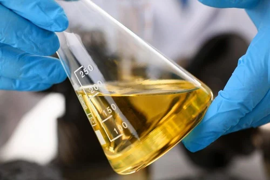Our Product
Engineering compounds
Engineering compounds are a type of plastic that, when combined with special additives such as glass fibers, minerals, and other reinforcements, enhance their properties. These compounds are used in the production of various plastic products and are widely chosen in numerous industries due to their high strength, resistance to heat and chemicals, extended lifespan, and excellent moldability.
Engineering compounds can be specifically designed for particular applications and environments, providing better performance than regular plastics.
Introduction to Engineering Compounds
Engineering compounds refer to plastics that are reinforced with specific additives such as glass fibers, minerals, and other strengthening agents. These plastics are typically produced using polymers like polyethylene and polypropylene as a base and can be made from either virgin or recycled materials. The composition of these plastics is carefully formulated to ensure product quality and performance.
During manufacturing, engineering compounds incorporate compatibilizers to address defects and enhance product functionality. As a result, these compounds outperform conventional plastics and have gained popularity across various industries. Engineering compounds can also serve as an alternative to masterbatches, leading to more cost-effective production.
Due to the inclusion of mineral additives, these plastics contribute to environmental sustainability by reducing ecological damage. They are widely used in the automotive, piping and fittings, electrical appliances, and household industries. In the automotive sector, for instance, engineering compounds are utilized to manufacture durable and safe plastic components.
Plastic pipes made from engineering compounds offer advantages over metal pipes, such as improved water flow and reduced iron-related contamination. In the electrical industry, these compounds are used for wire insulation and casing. Similarly, in household appliances, they help create lightweight yet durable components.
Advantages of Using Engineering Compounds
Engineering compounds come in various types, each offering unique properties tailored to specific manufacturing challenges. Incorporating these compounds in plastic production enhances quality, minimizes defects, and optimizes the final product. These plastic components are customized to meet the specific demands of each industry, delivering superior performance and distinctive characteristics.
Some key benefits of using engineering compounds in various industries include:
-
Increased heat resistance
-
Enhanced tensile strength
-
Reduced wear and scratches
-
Improved chemical resistance
-
Dimensional stability
-
Retained flexibility and moldability
-
Longer lifespan compared to conventional plastics
-
Reduced production time and costs
Engineering compounds belong to the broader category of polymer compounds. In situations where masterbatches are unsuitable, engineering compounds offer an effective alternative by significantly improving product properties. Additionally, their use lowers production costs and streamlines manufacturing processes.
Types of Engineering Compounds
These plastics are available in various forms, tailored to industry-specific requirements. Some common types include:
-
Polyethylene-based engineering compounds
-
Polypropylene-based engineering compounds
-
Glass fiber- or mineral-reinforced engineering compounds
These compounds are specially developed for specific applications, ensuring the best possible performance for each product.
Final Thoughts
For high-quality engineering compounds, Bespaar Dovam Shimi is one of the most reputable manufacturers and suppliers. This company offers various engineering compounds, including polyethylene, polypropylene, and glass fiber-reinforced compounds, making it a reliable choice for multiple industries. By purchasing from this company, you can access high-quality products at competitive prices, ensuring optimal production results.
Frequently Asked Questions
What is an engineering compound?
An engineering compound is a type of plastic that is enhanced with reinforcing materials such as glass fibers and minerals to improve its properties. These compounds are designed for specific applications and provide superior performance compared to regular plastics.
What are the applications of engineering compounds?
Engineering compounds are used in industries such as automotive, piping and fittings, electrical appliances, and household products. Due to their high durability, extended lifespan, and flexibility, they serve as an ideal choice for these sectors.
Can engineering compounds be made from recycled materials?
Yes, these compounds can be manufactured using either virgin or recycled materials. Using recycled materials helps reduce costs and promotes environmental sustainability in the production process.
Why use engineering compounds instead of masterbatches?
Engineering compounds can be an excellent alternative to masterbatches in plastic production. They are particularly useful when masterbatch-polymer blending is not feasible, as they enhance product quality while reducing production costs.
Polyurethane resin
Polyurethane resin is a highly versatile polymer that plays a vital role in various industrial and commercial applications. Known for its unique combination of strength, flexibility, chemical resistance, and excellent adhesion, polyurethane has become a go-to material in industries ranging from construction and automotive to textiles, electronics, and coatings. Its adaptable chemistry allows it to be formulated into different types—rigid, flexible, water-based, solvent-based, and solvent-free—each tailored to meet specific performance demands. Whether used as a protective coating, adhesive, foam, or structural component, polyurethane resin offers outstanding durability and performance across a wide range of environments.
What is Polyurethane Resin (PU)?
Polyurethane resin is a type of polymeric resin created through a chemical reaction between diisocyanates and polyols (alcohol compounds). This reaction forms a versatile polymer structure with unique chemical and physical properties.
PU resin acts as a binding agent that holds other components together and provides the base for various applications. It is widely used in textile manufacturing, construction, automotive industries, and more.
Origins of Polyurethane Resin
🔹 Natural Origin
Naturally-derived polyurethane resins are often referred to as natural polyesters. These are produced from plant-based oils or other renewable resources. In earlier times, natural oils were widely used in the production of polyurethanes. However, with the rise of synthetic chemistry and petrochemical technologies, the industrial use of natural PU resins has significantly declined.
🔹 Synthetic Origin
Synthetic polyurethane resins are made from petrochemical sources, particularly through the reaction of isocyanates and polyols. These raw materials are often derived from oil-based compounds.
By adjusting the ratio between the isocyanates and polyols and incorporating additives like urea-formaldehyde, epoxy resins, or polyesters, various PU resin types can be engineered for specific industrial purposes such as coatings, adhesives, and flexible foams.
How is Polyurethane Resin Formed?
The formation of polyurethane resin involves a chemical reaction called polyurethanization, which occurs between two main reactants:
🔸 Reactants:
Isocyanates (–NCO groups): These are reactive compounds containing the NCO functional group.
Hydroxyl groups (–OH groups): These are found in alcohol-based compounds (polyols).
When these two substances are combined, they form urethane bonds, resulting in a durable polymer structure.
After the initial formation, modifiers or additives can be introduced to tailor the resin’s properties, such as:
Mechanical strength
Elasticity
Water and heat resistance
Chemical durability
This tunability makes polyurethane resins suitable for diverse applications ranging from flexible foams to rigid coatings and industrial adhesives.
History of Polyurethane Resin
The discovery of polyurethane dates back to the 1930s. It was during this time that chemists were exploring new polymeric materials.
In 1937, German chemist Dr. Otto Bayer and his research team made a breakthrough by reacting polyethylene glycol (PEG) with isocyanates. This unexpected reaction produced a new compound with unique and promising properties.
At the time, isocyanates were mostly used in pharmaceuticals and had limited industrial applications. Dr. Bayer’s discovery paved the way for the use of polyurethane in manufacturing and industry.
Throughout the 1940s and 1950s, extensive research was carried out to optimize the properties of polyurethane resins.
By the late 1950s, commercial production of polyurethane had begun. The material quickly gained popularity in a range of industries, including:
Automotive
Construction
Furniture and foam
Coatings and adhesives
Today, polyurethane resin remains a key material in modern manufacturing, with ongoing innovations to improve its environmental performance, recyclability, and performance characteristics.
Properties of Polyurethane (PU) Resin
Polyurethane resin is a versatile polymer material widely used in numerous industries due to its unique chemical and physical properties. Some of its most notable characteristics include:
1. Strength and Flexibility
PU resin exhibits a high level of mechanical strength along with excellent flexibility. These properties make it suitable for manufacturing a wide range of products, from coatings to flexible foams.
2. Abrasion and Impact Resistance
This resin is highly resistant to abrasion and mechanical shocks. It is often used in applications that require durability and long-term performance under stress, such as flooring and protective coatings.
3. Chemical Resistance
PU resins demonstrate high resistance to various chemicals, including solvents, oils, and acids. This makes them ideal for use in harsh environments like industrial settings and chemical processing plants.
4. Excellent Adhesion
Polyurethane resins have superior adhesive properties, allowing them to bond well with different materials. This feature makes them valuable in adhesives, sealants, and surface coatings.
5. Electrical Resistance
Many polyurethane resins offer strong electrical insulation properties, making them suitable for use in electronic components and connectors.
Types of Polyurethane Resin
Polyurethane resin can be categorized in different ways based on its formation method and physical state. Here are two common classification methods:
I. Classification by Film Formation Process
This classification divides polyurethane resins into one-component (1K) and two-component (2K) systems based on how they form solid films:
1. One-Component Polyurethane Resin (Thermoset)
This type of resin consists of a single prepolymer component.
It is characterized by low viscosity, excellent elasticity, and strong adhesion.
Commonly used as floor coatings and surface protectants.
It is easy to apply due to its self-curing nature, requiring only ambient moisture or temperature to initiate curing.
2. Two-Component Polyurethane Resin (Thermoplastic)
Composed of two separate components: usually a polyol and an isocyanate.
These components are mixed just before application.
Known for high abrasion and impact resistance.
Widely used in concrete coatings, industrial flooring, automotive parts, and architectural elements.
II. Classification by Physical State
PU resins are also classified based on their physical form:
1. Solid Polyurethane Resin
Usually supplied as a powder.
Requires heat to melt and flow during application.
Common in thermoplastic PU processing like injection molding or powder coatings.
2. Liquid Polyurethane Resins
These are further categorized into:
a. Water-Based Polyurethane Resin
Uses water as the primary solvent.
Environmentally friendly and low in volatile organic compounds (VOCs).
Offers water resistance, flexibility, and adhesion.
Widely used in textiles (e.g., waterproof fabrics), construction (as adhesives and sealants), and water-based paints and coatings.
b. Solvent-Based Polyurethane Resin
Contains organic solvents (e.g., oils) as the main carrier.
Provides softening and flexibility properties to the final material.
Suitable for wood coatings, automotive finishes, and leather coatings.
c. Solvent-Free Polyurethane Resin
Designed without organic solvents.
Environmentally safe and reduces health risks related to VOC exposure.
Used in sensitive applications such as food packaging, medical devices, and eco-friendly flooring.
Properties of Polyurethane (PU) Resin
Polyurethane resin is a versatile polymer material widely used in numerous industries due to its unique chemical and physical properties. Some of its most notable characteristics include:
1. Strength and Flexibility
PU resin exhibits a high level of mechanical strength along with excellent flexibility. These properties make it suitable for manufacturing a wide range of products, from coatings to flexible foams.
2. Abrasion and Impact Resistance
This resin is highly resistant to abrasion and mechanical shocks. It is often used in applications that require durability and long-term performance under stress, such as flooring and protective coatings.
3. Chemical Resistance
PU resins demonstrate high resistance to various chemicals, including solvents, oils, and acids. This makes them ideal for use in harsh environments like industrial settings and chemical processing plants.
4. Excellent Adhesion
Polyurethane resins have superior adhesive properties, allowing them to bond well with different materials. This feature makes them valuable in adhesives, sealants, and surface coatings.
5. Electrical Resistance
Many polyurethane resins offer strong electrical insulation properties, making them suitable for use in electronic components and connectors.
Types of Polyurethane Resin
Polyurethane resin can be categorized in different ways based on its formation method and physical state. Here are two common classification methods:
I. Classification by Film Formation Process
This classification divides polyurethane resins into one-component (1K) and two-component (2K) systems based on how they form solid films:
1. One-Component Polyurethane Resin (Thermoset)
This type of resin consists of a single prepolymer component.
It is characterized by low viscosity, excellent elasticity, and strong adhesion.
Commonly used as floor coatings and surface protectants.
It is easy to apply due to its self-curing nature, requiring only ambient moisture or temperature to initiate curing.
2. Two-Component Polyurethane Resin (Thermoplastic)
Composed of two separate components: usually a polyol and an isocyanate.
These components are mixed just before application.
Known for high abrasion and impact resistance.
Widely used in concrete coatings, industrial flooring, automotive parts, and architectural elements.
II. Classification by Physical State
PU resins are also classified based on their physical form:
1. Solid Polyurethane Resin
Usually supplied as a powder.
Requires heat to melt and flow during application.
Common in thermoplastic PU processing like injection molding or powder coatings.
2. Liquid Polyurethane Resins
These are further categorized into:
a. Water-Based Polyurethane Resin
Uses water as the primary solvent.
Environmentally friendly and low in volatile organic compounds (VOCs).
Offers water resistance, flexibility, and adhesion.
Widely used in textiles (e.g., waterproof fabrics), construction (as adhesives and sealants), and water-based paints and coatings.
b. Solvent-Based Polyurethane Resin
Contains organic solvents (e.g., oils) as the main carrier.
Provides softening and flexibility properties to the final material.
Suitable for wood coatings, automotive finishes, and leather coatings.
c. Solvent-Free Polyurethane Resin
Designed without organic solvents.
Environmentally safe and reduces health risks related to VOC exposure.
Used in sensitive applications such as food packaging, medical devices, and eco-friendly flooring.
Conclusion
In summary, polyurethane resin is a cornerstone material in modern manufacturing and engineering thanks to its diverse properties and formulation options. From one-component sealants to high-performance industrial coatings, PU resin continues to offer reliable solutions that balance functionality, environmental safety, and cost-effectiveness. As industries push for more sustainable and high-performance materials, polyurethane’s adaptability ensures its continued relevance and innovation across sectors.
Frequently Asked Questions (FAQs)
1. What is polyurethane resin used for?
Polyurethane resin is used in a wide variety of applications including adhesives, paints, coatings, sealants, flooring systems, furniture foams, insulation panels, and automotive parts due to its durability and versatility.
2. What is the difference between one-component and two-component PU resin?
One-component PU resins cure through exposure to air or moisture and are easier to apply, while two-component resins require mixing of two parts before use, offering superior strength and chemical resistance.
3. Is polyurethane resin environmentally friendly?
Water-based and solvent-free polyurethane resins are considered more environmentally friendly as they emit fewer volatile organic compounds (VOCs). However, solvent-based types may raise environmental and health concerns without proper handling.
4. Can polyurethane resin be used outdoors?
Yes, many polyurethane resins are UV-resistant and weatherproof, making them suitable for outdoor use, particularly in protective coatings, sealants, and waterproofing applications.


